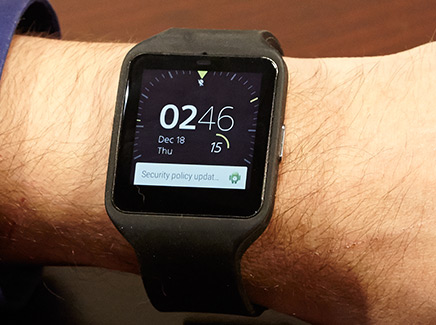Tom's Guide Verdict
The Sony SmartWatch 3 is the first Android Wear device with built-in GPS, but you can't do enough with it.
Pros
- +
Attractive design
- +
Good battery life
- +
Built-in micro USB charging port
Cons
- -
Built-in GPS only works with a few apps
- -
Expensive
- -
Limited app selection
- -
Confusing OS
Why you can trust Tom's Guide
Sony has more experience than any other company in creating smartwatches, having released its first connected wrist piece, the Live View, back in 2010. Its fourth-generation product, the Sony SmartWatch 3, has a more refined design and longer battery life. And with built-in GPS, the watch can be used without a phone tethered to it, making it potentially more useful to those who want to exercise without strapping a phablet to their arm. But while the hardware of this $249 Android Wear device is sound, the software still needs to catch up.
Design
It's not as sleek as the circular Moto 360, but I like the thin profile of the Sony SmartWatch 3. It sat low on my wrist, and never got caught on my sleeves. It's a definite improvement over previous generations, but isn't quite as elegant as the Asus ZenWatch, another square-faced device.
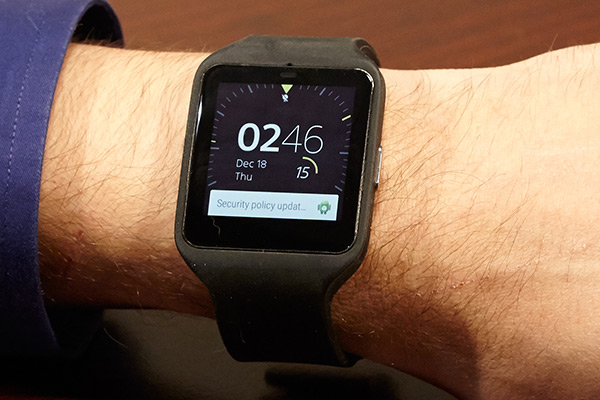
The face and bezel are a glossy black, while the button on the right and underside are stainless steel.
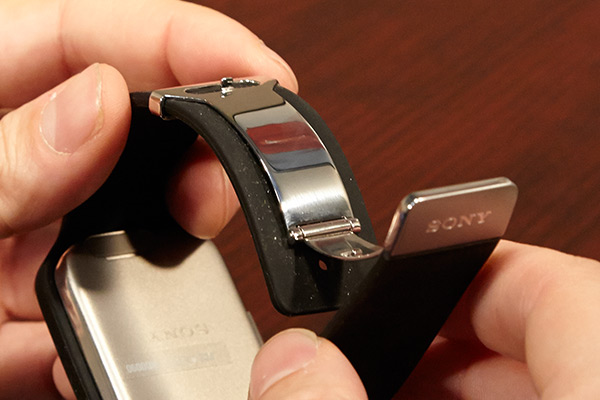
Unlike Sony's previous smartwatch, which had a more traditional watchband, the SmartWatch 3's band wraps around the face of the device, which gives it a slightly sportier feel than other smartwatches.

The band is made of a soft, rubberlike material that felt comfortable on my wrist but was quick to pick up dust and lint. Its clasp is a sort of hybrid between a deployant clasp (a hinged piece of metal) and a traditional tang-type buckle (like you'd find on a belt). I wish Sony had gone with the latter, as this clasp would sometimes pop open if it got caught on my sleeve. Unfortunately, competitors such as the Asus ZenWatch also use this type of annoying clasp.
MORE: Best Smartwatches
The watch itself pops out of the band, so if you don't like black, you can purchase the strap in white, pink or green. However, you can't replace any of these with a standard watchband.
Get instant access to breaking news, the hottest reviews, great deals and helpful tips.
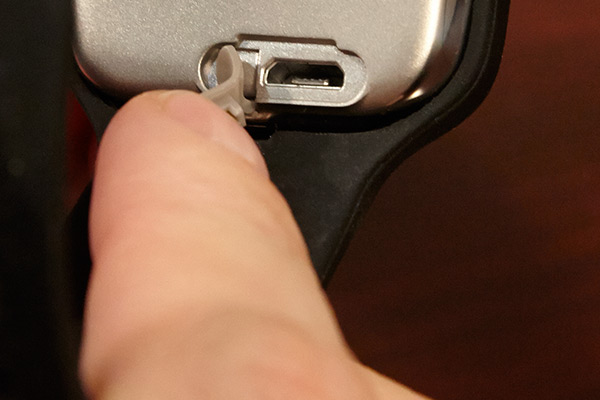
Kudos to Sony for including a micro USB port on the SmartWatch 3; unlike most other smartwatches, which require some sort of proprietary charging cradle, you can simply plug a USB cable into Sony's device. You do have to peel back a rubber cover first, though.
The SmartWatch 3 is rated to withstand being submerged in up to 4.9 feet of water for 30 minutes. Just make sure the charging cover is secure.
Display
As is becoming standard, the 1.6-inch transflective LCD on the SmartWatch 3 has a resolution of 320 x 320 pixels.
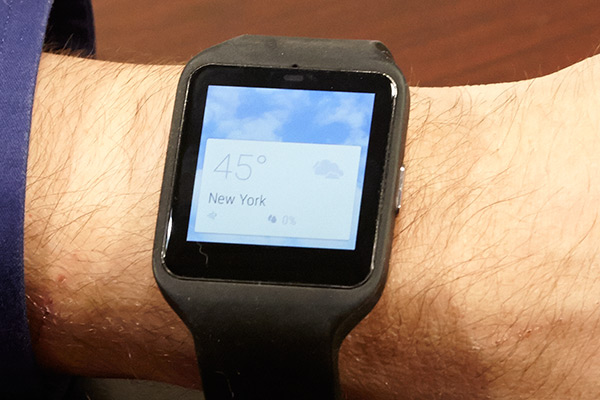
Even in its dimmed mode, the screen was fairly easy to view, even in sunlight. Raising the watch to my face turned the display on to its full brightness, but it occasionally took a forceful turn of my wrist to do so.
Performance
The SmartWatch 3 is powered by a 1.2GHz ARM A7 processor and 512MB of RAM. Swiping through cards and menus was fast and smooth, and I never saw the watch stutter. The watch also has 4GB of built-in storage, so you can load it up with music for when you go for a run and don't want to bring your phone with you.
MORE: Apple Smartwatch: What You Need to Know
The SmartWatch 3 also has built-in Wi-Fi, but this feature has not been activated yet.
GPS
The Sony SmartWatch 3 is the first Android Wear watch with built-in GPS. For runners like me, this is a potentially killer feature, as it means I don't have to take my phone with me when I go for a run.
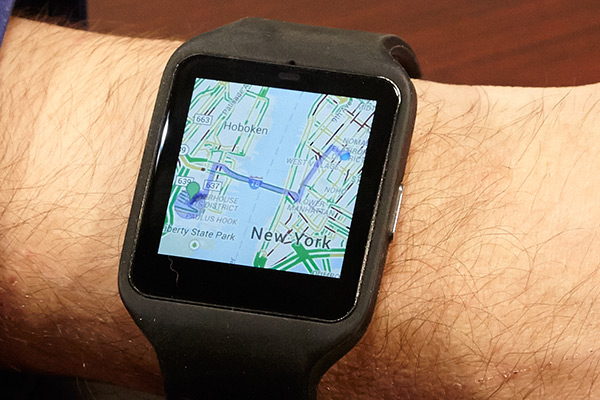
Unfortunately, as with Android Wear as a whole, the hardware is limited by the software. Of the most popular apps in the Health & Fitness category (RunKeeper, Runtastic and Strava), none can use the SmartWatch 3's GPS directly. In fact, as of the time this review was written, the only apps that can use the SmartWatch 3's GPS are My Tracks, iFit Outside and Golfshot Golf GPS.
The one potential workaround is that you can link My Tracks to Google Fit, which you can then link to MapMyRun or RunKeeper. However, you'll still miss out on running-specific prompts, such as pace, speed and split times.
Android Wear
Google's mobile operating system, Android Wear, is improving but still remains confusing to use.
When you tap the watch face, the updated interface shows, in order, a button to launch Google Now, your most recently used app, Settings and then a bunch of other suggestions of what you can do with the watch. At the very bottom are options to start music and to launch apps. It's a minor improvement, but a welcome one — it would be great, for instance, if I could reorder the items in the list.

Notifications from your phone are presented as cards. For example, if you receive an email, it will appear on the screen, and you can swipe to the right to open the message on your phone. However, the quality of a notification depends greatly on its source. While you'll be able to read an entire email from a Gmail account and send a canned response, you'll only receive partial messages from other sources. Sometimes, you only get part of the subject line, and that's it. And, even with Gmail, you can only see the most recent messages, and not your entire inbox.
MORE: Android Wear vs. Pebble: Smartwatch Face-Off
What's also frustrating is that once you swipe away a card, it only reappears when Google deems it important. At random times, the watch would show me cards for the weather, scores from the previous day's football games, old emails and the weather. Once you swipe away those cards, they're gone. Yes, you can say, "OK, Google, what's the weather?" but it would be a lot more useful if I could just swipe once to see if it's raining.
The number of Android Wear apps is increasing, but the pace is glacial. When I wrote this review, there were about 170 apps available in the Google Play store, including Google+, Yo, Tinder, Facebook Messenger and WhatsApp. That pales in comparison to Pebble's app store, which has more than 3,000 apps.
As with all Android Wear devices, the SmartWatch 3 can be paired with Android devices running version 4.3 or later.
Sony doesn't preload any apps with the SmartWatch 3, so you'll have to find third-party apps to, for instance, unlock your phone or detect a lost phone. If you do decide to get an Android Wear watch, I highly recommend installing the Wear Mini Launcher app. This gives you much quicker access to apps installed on the watch, as well as settings such as brightness and volume controls.
Battery Life
The 420-mAh battery is a bit larger than what you'll find in most other smartwatches, which top out at around 320 mAh. I was able to get through the day on a single charge, but using the GPS drained the battery much faster, which is to be expected.
Bottom Line
As fitness bands gain more and more smartwatchlike features, it's only natural that smartwatches pick up some tricks from their sportier counterparts. That's what initially made the Sony SmartWatch 3 so appealing to me. As a runner, I thought I could have a GPS watch when I went on my training runs and that it would still be useful for all other times. If GPS isn't as big of a concern for you, though, the Pebble Steel offers a much greater number of apps, works with Android and iOS, and will soon get the benefit of Android Wear-style notifications. Among Android Wear devices, I prefer the more stylish Moto 360 or LG G Watch.
It's too bad that the Sony SmartWatch 3, like all other Android Wear devices, is still a work in progress. What good is having a built-in GPS chip if there aren't any apps that take full advantage of it? And while Android Wear is slowly improving, it's still far too cumbersome to be truly useful as a smartphone companion. I like where Sony is going, but for now, I'm going to stick to a real GPS watch, like the TomTom Runner Cardio, for my workouts.
- 100+ Gift Ideas for Men and Women
- 15 Best iPhone Apps You're Not Using
- 10 Killer Features for The Apple iWatch
Follow Michael A. Prospero @mikeprospero and on Google+. Follow us @TomsGuide, on Facebook and on Google+.

Michael A. Prospero is the U.S. Editor-in-Chief for Tom’s Guide. He oversees all evergreen content and oversees the Homes, Smart Home, and Fitness/Wearables categories for the site. In his spare time, he also tests out the latest drones, electric scooters, and smart home gadgets, such as video doorbells. Before his tenure at Tom's Guide, he was the Reviews Editor for Laptop Magazine, a reporter at Fast Company, the Times of Trenton, and, many eons back, an intern at George magazine. He received his undergraduate degree from Boston College, where he worked on the campus newspaper The Heights, and then attended the Columbia University school of Journalism. When he’s not testing out the latest running watch, electric scooter, or skiing or training for a marathon, he’s probably using the latest sous vide machine, smoker, or pizza oven, to the delight — or chagrin — of his family.
-
Daniel Law You just missed the Runkeeper update before writing this review. Now Runkeeper supports Sw3 onboard GPS without using phone. Tested it today and it works great!Reply -
mprospero I'll have to check that out Dan. Thanks for the tip. However, my point still remains - Runkeeper can't be the only app that uses the built in GPS.Reply
